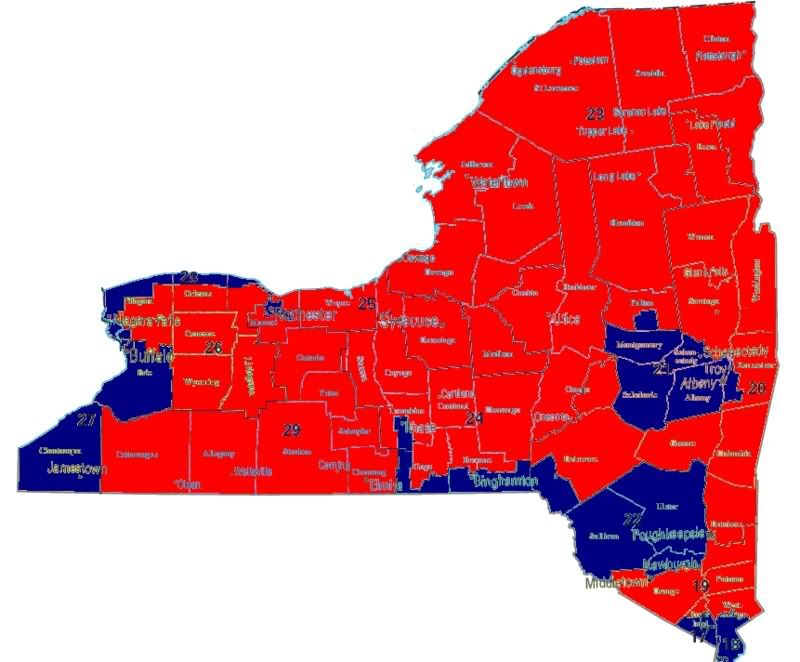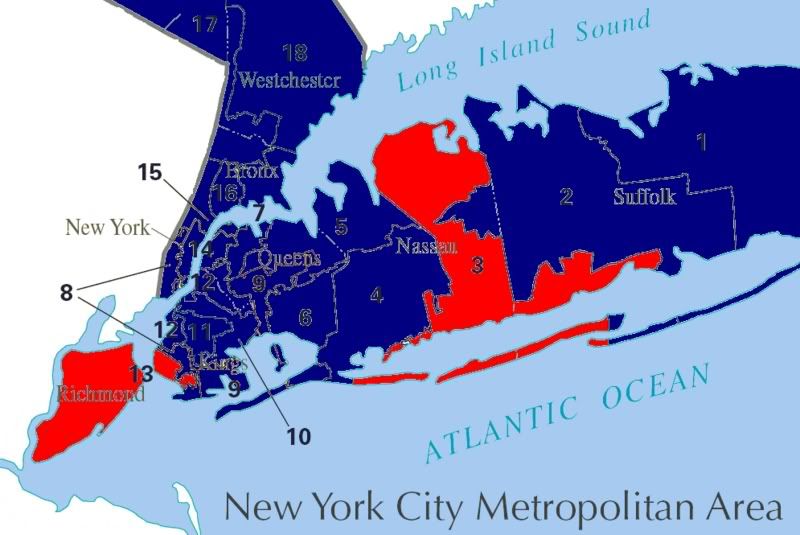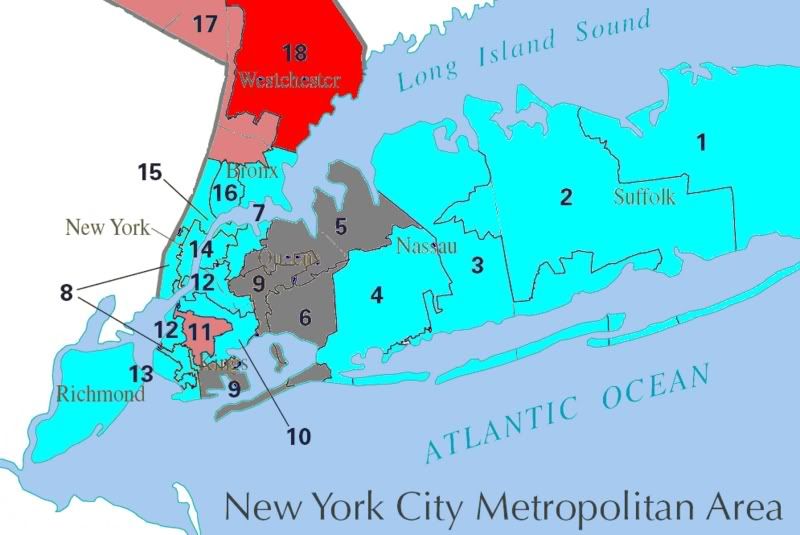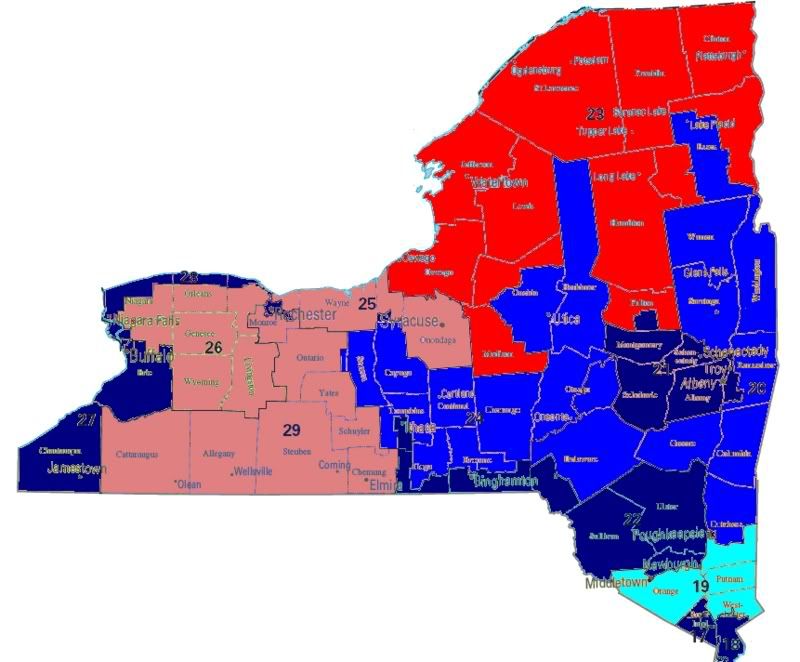(From the diaries. I like maps. – promoted by James L.)
This is the second in a series of diaries graphically depicting the Democratic victory in this year’s midterm elections. The first diary in this series covering New England may be seen here.
Today we will be looking at Democratic gains in New York, both in the city and upstate. First, the money shot, maps detailing simple change in district control, because no seats changes hand in the NYC area the city inset will only be displayed after the fold under the 2006 results.
2004

2006

NYC

Of 3,561,072 votes cast in 2006 US House races in New York, 2,285,020 (64.2%) were cast for Democrats, while 1,266,295 (35.2%) were cast for Republicans.
Democrats took the open seat in the NY-24 (Utica), with Arcuri (D) defeating Meier (R) by 16,469 votes, 53.8% D to 45.2% R.
Democrats defeated Republican incumbents in the NY-19 and NY-20. In the NY-19 (Orange/Putnam County), Democrat John Hall beat Republican incumbent Sue Hall by 13,642 votes votes, 51.2% D to 48.8% R. In the NY-20 (Upper Hudson valley) Democrat Kirsten Gillibrand defeated Republican incumbent John Sweeney by 13,642 votes, 53.1% D to 46.9% R.
The following map shows Democratic gains over their 2004 Democratic performance in the district (in % terms), improvements of less than 5% will be displayed in light blue, under 10% in the darker blue, and over 10% in the darkest blue. Republican gains will be shown in the same manner, with the light red signifying a gain of less than 5% and so on. Races that were contested in neither year will be displayed in gray.


The single greatest Democratic gain in a race contested by Republicans in 2004 was in the NY-27 (South Buffalo) where Democratic incumbent Brian Higgins surged by 25.9% over his 2004 performance. Democratic candidates in the NY-19, NY-20, and NY-24 all improved upon 2004 Democratic performance by more than 10%. Candidates in the NY-1, NY-3, NY-20, NY-22, and NY-29 all improved upon 2004 Democratic performance by over 5%. Again, the races coded in the light blue showed less than 5% improvement over 2004. The only red spot was in the NY-18 where Democratic incumbent Nita Lowey saw her vote share drop from 81.3% in 2004 to a mere 70.3% this year. This is the only kind of victory Republicans could muster in the Empire state.
Looking more closely at the margin of victory in 2006 races & the scale of Democratic victory in this midterm, and pickup opportunities emerge, the following map displays the margin of victory in 2006 races. The deepest blue represents and Democratic margin of victory over 10%, the medium color represent more than 5%, while the lightest blue indicates that the Democratic candidate won by less than 5%. Corresponding measures of Republican victory margins display progressively darker shades of red at the same intervals.

What emerges is a map to guide our 2008 strategy. Beginning with this edition of the series I will be producing a tier system for 2008 races based upon the results of the 2006 returns. Tier 0 races are those where the Democratic candidate won by a margin of less than 5%, the presumption being that incumbency grants an advantage of 5-10% that with the fundraising advantage that comes with holding office should be sufficient for these candidates to defend their seats without funding from the party. The assumption that incumbency gives a 5-10% advantage drives the classification of the pickup categories. Tier 1 races are those where the incumbent won by less than 5% in 2006, while tier 2 races are those where Republicans won by less than 10%.
Tier 0
Race D% R% Margin 2006 D Cand.
NY-19 51.2 48.8 6.1 John Hall
Tier 1
Race D% R% Margin 2006 D Cand.
NY-25 49.1 50.9 1.9 Dan Maffei
NY-29 48.5 51.5 3.1 Eric Massa
NY-26 48.1 51.9 3.7 Jack Davis
Tier 2
Race D% R% Margin 2006 D Cand.
No races meet the criteria for this tier.
While our one defend NY-19 is near NYC in Orange/Putnam counties, the 3 2008 Dem Pickup opportunties are in Western New York with the NY-25 in the Rochester/Syracuse area the NY-26 is between Rochester and Buffalo, and the NY-29 is immediately to the south of that. Jack Davis self funded his campaign run on a pro-fair trade message, while Massa and Maffei were relative newcomers to politics. (New Yorkers please correct me if I got this wrong.)
Building upon the Tier 0 race in the NH-01 and the Tier 1 race in the CT-04, this means that my running total shows two Tier 0 races to defend in 2008 and four Tier 1 pickup opportunities. I strongly believe that if we want to win we need to maintain our infrastructure in these close races. If our 2006 candidates want to run in 2008, absent a compelling reason to challenge them in the primary. And if we know who the 2008 candidate is going to be we need a continuing netroots effort to give these candidates a running start on 2008. In the form of seed money, the netroots can press forward on our 2006 Democratic gains defining the battlefield for 2008. We must not allow the Republicans to define the battlefield for the next cycle, and only by providing minimial funding to allow the candidate to retain a single staffer to fundraise and keep the infrastructure intact can we make this work.
This is a logical continuation of the 50 State Strategy, by keeping the infrasructure intact there’s no need to start all over in 2008, and that will allow campaigns to be more efficient in their use of funds. If we can avoid the first spending the first $25,000-$50,000 needed to reconstitute the campaign infrastructure in each cycle we will be able press further into Republican held districts. Our goal must be to contain the Republicans to their base in the Deep South, no Copperhead must go unchallenged.
I hate snakes.
And I’ve been thinking about something related to your idea of continuing infrastructure – I want to think about what lessons can be drawn from candidates who have lost once and come back to win the second time. My initial focus at least is of course on Paul Hodes, but I want to look for other cases. Surely there’s something to be learned there.
& elections results info. Great!
Yes Maffei & Massa fall into the “novice” categories as candidates. Maffei was a Congressoninal Aide and Massa was an aide to frmr Gen. Wesley Clark.